MRO Activities in Aviation Industry
| ✅ Paper Type: Free Essay | ✅ Subject: Engineering |
| ✅ Wordcount: 3160 words | ✅ Published: 30 Aug 2017 |
Definitions:
MRO: Maintenance, repair and overhaul organization.
OEM: Aircraft original equipment manufacturers. Such as Airbus, Boeing, Bombardier Embraer and others.
Airworthiness Authorities: Regulate all aspects of civil aviation. These include the construction and operation of airports, the management of air traffic, the certification of personnel and aircraft. There are two main organizations, the Federal Aviation Administration (FAA) of the United States of America and the European Aviation Safety Agency (EASA).
Airworthiness: FAA Part 3 defines Airworthy as, the aircraft conforms to its type design and is in a condition for safe flight. A more generic and non-process oriented definition is required. Airworthiness is defined in JSP553 Military Airworthiness Regulations (2006) Edition 1 Change 5 as: The ability of an aircraft or other airborne equipment or system to operate without significant hazard to aircrew, ground crew, passengers (where relevant) or to the general public over which such airborne systems are flown.
Mother airline: In MRO aviation sector mother airline is the core airline from with the MRO unit segregates, for instance British Airways is the mother airline of British Airways Engineering.
Virtual airline: Is an airline that has outsourced as many possible operational and business functions as it can, but still maintains effective control of its core business.
Line Maintenance: Usually carried out at or near the aircraft dock or parking. The level of dis-assembly is usually limited to what can be reassembled and restored within a short period in order to allow the continuous aircraft operation. A limiting factor is usually the level of Ground Support Equipment and the scope of the revisions reaches to the A-Check.
Heavy Maintenance: The mayor level of maintenance with capabilities of disassembling, inspecting, repairing, refurbishment, overhaul and restoration. It is usually carried out into specific installations called Hangars with and extensive source of facilities, tools and equipment. The scope of the revisions in this kind of maintenance is focus in C-Checks and in mayor structural repairs and inspections.
Engine Overhaul: Comprises of the whole disassembly of an engine. The overhaul facility inspects the engine, repairs it as necessary, reassembles, tests, clean and approves it for return to service within the fits and limits specified by the manufacturer’s overhaul data (Lee et al, 2008). This kind of maintenance need to be done in a very specific installations approved by the engine manufacturer.
Component Maintenance: Reparation of aircraft components is slightly different from a complete overhaul, as the workshop needs to determine the cause of a given defect, correct that defect, perform bench tests and release the component back to service. Very specific workshops needed for different components such as: Radio transceivers, Hydraulic valves, batteries, passengers seats, etc.
Modifications: This kind of maintenance is performed in order a manufacturer option or an authority requirement. During the manufacturing process of an aircraft, improvements have been implemented over time, for early versions, these improvements can be made later in the form of modification, on the other hand civil aviation authorities generates Airworthiness Directives (AD) of mandatory compliance to the aircraft operators , that needs specific modifications.
Introduction
Maintenance, repair and overhaul in the aeronautical sector is a complicate procedure that has strict and particular requirements defined by airworthiness authorities to guarantee the safety of passengers and aircrew. MRO could be defined such “all actions that have the objective of retaining or restoring an item in or to a state in which it can be perform its required function”. (Vieira, Loures, 2016).
The aviation MRO engineering could be defined such the arm of the aviation industry responsible for the retaining or restoring aircraft parts to a state in which they can perform the required design applications (Al-kaabi, Potter et al. 2007). Chang and Abdullah (2014) states that the business model of the MRO is a combination of technical capacity and logistic configuration counting the level of supply chain vertical integration and outsourcing practices. Chris Markou (2015) estimates the maintenance cost for an airline is 17% of the operational cost.
MRO Activities and Models:
Al-kaabi, Potter et al (2007) study assesses the decision-making process of an airline when deciding on the outsourcing of maintenance services, the study define three different phases:
The first phase corresponds to the activities developed by the MRO, in this section the critical activities of the organization that are included (figure 1).
The second phase deals with the study of demand based on a series of entries that will take into account the logistical complexity, the age of the fleet and its use, among others. The MRO have to focus on the actual market and need to develop a plan strategy for short, medium and long term.

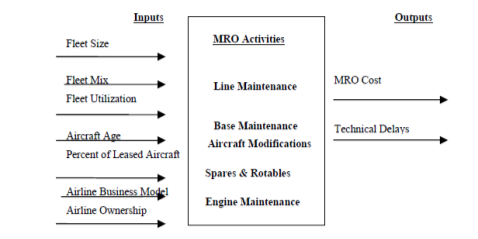 The third phase addresses the study of capacity and the true need to outsource taking into account the MRO cost, that include maintenance resources such hangar space, qualified equipment , qualified manpower and the dispatch reliability related with technical delays.
The third phase addresses the study of capacity and the true need to outsource taking into account the MRO cost, that include maintenance resources such hangar space, qualified equipment , qualified manpower and the dispatch reliability related with technical delays.
During 2014 Global Market of MRO spends was value at %62.1 billion, excluding overheads, with a 3.8% increase per annum, the market size is estimated to reach $90 billion in 2024 (Chris MARKOU, 2015). The following graph represents the distribution of cost between MRO activities for the year 2014.

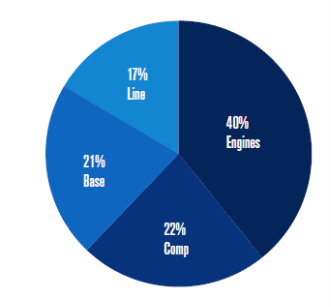
Al-kaabi, Potter et al (2007) states that according with the critical activities of an MRO and the level of outsourcing developed, a MRO could be categorized in different models:
- Fully Integrated MRO: Where all MRO activities are generated and performed internally and in addition the MRO can support other airlines different to the mother airline generating external revenues.
- Partially Outsourced MRO: Where airlines try to maintains most of their MRO activities internally but some are externalised, for example the outsourcing of the Engine Maintenance.
- Mostly Outsourced MRO: Where only critical activities are performed internally for instance, generally airlines consider Line maintenance such a critical activity for the relation with the punctuality, for this reason is maintained such as in house activity.
- Wholly outsourced MRO: Where all activities are outsourced, it is similar to the Virtual airline model and it is highly extended across the new Low-Cost airlines that cannot afford the initial investment to create their own MRO.
The following table represents an SWOT evaluation performed by Al-kaabi, Potter et al (2007) of the difference structure models.



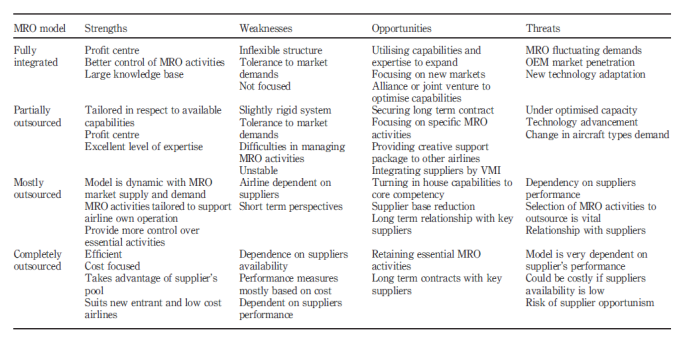 This variety of organizational models in which certain critical activities are externalized requires a maximum level of coordination between the actors involved, as well as within the organization itself. One of the leading issues in aviation industry today is how information is managed and retained in an organization (Flouris, Oswald 2006).
This variety of organizational models in which certain critical activities are externalized requires a maximum level of coordination between the actors involved, as well as within the organization itself. One of the leading issues in aviation industry today is how information is managed and retained in an organization (Flouris, Oswald 2006).
Regarding to the operational aspect of the MRO activities Vieira and Loures (2016) states that the maintenance could be:
- Scheduled Maintenance: Defined as an anticipatory action to ensure that a product works properly at pre-defined intervals. The intervals can be defined in terms of hours of operation, number of flights or flight cycles. (Figure 5).

 Unscheduled Maintenance: Defined as not planned or programmed is performed when an unexpected component failure occurs.
Unscheduled Maintenance: Defined as not planned or programmed is performed when an unexpected component failure occurs.
Actual MRO Scenario in aviation industry
Aviation MRO activities cannot be precisely defined solely within manufacturing or service term alone, Given that it is a product of both (Ayeni, Ball et al. 2016). The process are very complex, each component needs to be certified by the competent airworthiness institution which define severe requirements to guarantee safety (Vieira, Loures ,2016).
Due to the high quality requirements, there is a very small number of authorized companies to serve parts and services in the sector, this fact generates limitation in the options available when a MRO or manufacturer has to select the provider, creating a lack of influence to discuss commercial conditions.

 It can be highlighted four stakeholders in the service flow of an aviation MRO: Subtier/Supplier, Aircraft OEMs, Aircraft MRO and Customer. The flow model used by OEMs provides for key suppliers working as system integrator, this means in comparison with other sectors aircraft OEMs have very few suppliers approximately 50. The production parts is very standard and similar compared with other industrial sector, OEMs submit a purchasing order with the system supplier and making and respect a commercial agreement the part is delivered. The complexity increases with spare part due to the logistic and regulatory framework. Customers can purchase orders to the rest of the stakeholders always depending of the type of structure and also can request the MRO services.
It can be highlighted four stakeholders in the service flow of an aviation MRO: Subtier/Supplier, Aircraft OEMs, Aircraft MRO and Customer. The flow model used by OEMs provides for key suppliers working as system integrator, this means in comparison with other sectors aircraft OEMs have very few suppliers approximately 50. The production parts is very standard and similar compared with other industrial sector, OEMs submit a purchasing order with the system supplier and making and respect a commercial agreement the part is delivered. The complexity increases with spare part due to the logistic and regulatory framework. Customers can purchase orders to the rest of the stakeholders always depending of the type of structure and also can request the MRO services.
In order to obtain a complete an actual vision of the MRO sector, the following table shows the top 10 aviation MROs ordered by the number of airframe maintenance hours during 2014. (AW&ST, 2015)


MRO Procedures:
Lifecycles:
Two main flows can be identified within an MRO Aviation (CHANG, Abdullah 2014):
- The Physical flow: Is the aircraft maintenance process which comprises: professional methodology, material, machine, manpower and environment.
- The information flow: Defined as the company management process which comprises the cycle of P-D-C-A (Plan-DO-Check-Action) that includes functions of demand integration and material logistic.
These flows have to be analysed through the lifecycle of the different components of the Aviation MRO activity:

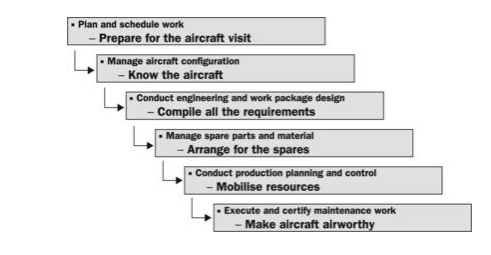

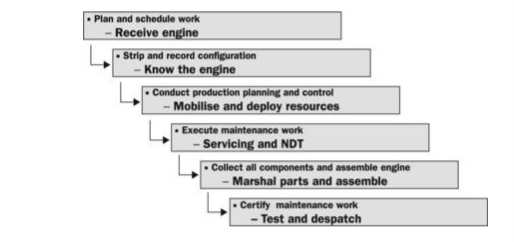

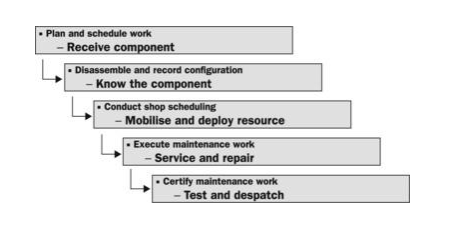
The previous diagrams show a generic lifecycle for the different elements with which MROs work, they are valid regardless of the level of outsourcing that the organization has, because it is the complete cycle, which would vary the organization that would perform the task in case they were outsourced.
Many common characteristics can be seen in the different cycles, such as logistics for the receipt and delivery of the product, personnel and tooling distributions, documentation and various final tests. During the development of the phases, the physical flow and the information flow must be taken care of equally.
Is very important visualize the wide intricacy of the MRO organization management (Bierer, Gtze et al. 2016).


The two types of flow mentioned above are then analyzed further in detail:
Physical flow
Regarding the physical flow, the maintenance process does not vary significantly with the product to be treated within the 3 life cycles previously exposed. Chang and Abdullah (2014) divides the aircraft maintenance process in 8 parts:
- Review Flight history: Make a review of previous maintenance actions and evaluate the current status.
- Determine Maintenance Items: Following manufacturer requirements and documentation, perform an engineering evaluation and determine the maintenance items.
- Receiving Process: Accept the aircraft from customer and perform the maintenance previous set-up.
- Disassembly: Gain access to the maintenance item.
- Inspection and testing: Perform the evaluations and approved test to ensure the state of the maintenance item.
- Assembly: Substitute and assembly the relative parts of the maintenance item, including de aces panel to the maintenance item area.
- Functional test: Perform a functional test of the maintenance item.
- Flight test: In some maintenance action could be necessary a flight test to ensure achieve the original performance requirement according to the regulatory framework.
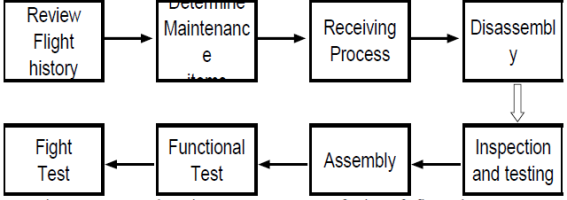
Figure 12: General Maintenance Process of Aircraft flow shop. Source: (CHANG, Abdullah 2014)
It can be seen the easy allocation of the parts to the previous discussed lifecycle in Figure 8. The complexity and the resources used in the maintenance task may vary, however the process remains essentially unchanged.
Information Flow
The information flow is the company management process, Chang and Abdullah (2014) argues that is composed by two major functions:
Demand integration: Divided in three stages:
- Delivery schedule: Where is necessary the management of customers’ orders taking into account the delivery date, aircraft model and requirements, this stage makes the link with the investment and business plan.
- Rough-cut capacity: Consider the information and the overall demand, during this stage the rough-cut capacity for midterm and long term is computed.
- Material requirement planning (MRP): In this stage inputs are receive from engineering evaluation (Bill of material), current inventory and current capacity, after the pertinent evaluation the detail production schedule is generated.
Material Logistic: Divided in three stages:
- Detail production schedule: Generated in the MRP phase, it is based in the feasibility of the production schedule, taking into account the lead time of the details parts, outsourcing level, procurements and resources.
- Shop floor control: This phase monitor the progress and daily performance in order to achieve the targets of the detail production schedule.

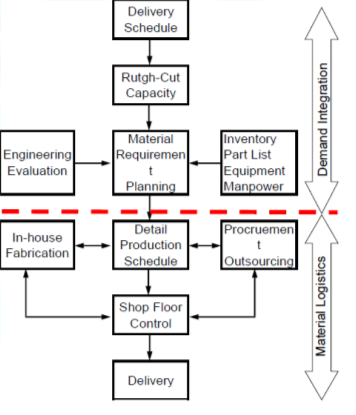 Delivery: After the maintenance task and checks, all the documentation and quality records should be prepared for reviewing and approval.
Delivery: After the maintenance task and checks, all the documentation and quality records should be prepared for reviewing and approval.
In this section it is necessary to differentiate information from knowledge. The information is the raw content of the metric being used, Gunasekaran, Patel et al (2001) use some of the following metrics in the aircraft maintenance process: Documents rejected, Defects at final inspections, Rework, Tool bag audit among others.

 Knowledge however is formed through the analysis and study of information, and gives a real vision of the state of the process as well as the achievement of objectives. Significant knowledge construction and application involves information to be accessible and relevant moment and relevant situation (Iyengar, Dharwada et al.).
Knowledge however is formed through the analysis and study of information, and gives a real vision of the state of the process as well as the achievement of objectives. Significant knowledge construction and application involves information to be accessible and relevant moment and relevant situation (Iyengar, Dharwada et al.).
One of the most important factors in the Aviation industry is how information is managed and retained in the organization. The concept of Knowledge Management in an organization is supply managers to with all the tools and knowledge necessary for decision making. Knowledge should be made available to the correct people at the correct time, and it must be sheltered so that this knowledge does not leave the organization. (Flouris, Oswald 2006).
Bierer, Gtze et al (2016) indicates that the knowledge management is necessary to obtain a successful generation and correct handling of knowledge, they also emphasize the tendency of MROs to outsource services by aggravating the problem of making knowledge accessible within the company.
Little literature exits on information management of the data obtained from various aircraft maintenance process which have direct consequence on the safety of the aircraft. (Iyengar, Dharwada et al. ). Nonetheless, in the publication the authors describe the hierarchy through different levels of the maintenance environment:
- Senior managers refers to the higher managers who reviews all the maintenance activities.
- Manager refers to the individual who reviews and report all the maintenance activities to the senior manager.
- Airline representative refers to the individual who performs day-to-day surveillance at the vendor location.
- Vendor refers to the independent maintenance operator who performs maintenance operations on the aircraft.


Human resources:
One of the most critical and most important components within the physical and information flows within an MRO is the human component, two main roles are mainly involved in the whole process (CHANG, Abdullah 2014).
- Engineer: The role is related with planning, certification liaison, and regulation, specifications to maintain the reliability, relations with financial departments and provide technical and analytical support.
- Technician: The qualified technician cover three main categories: structure repair, avionics and mechanical. The technicians are the main component of the manpower and they performed the designed maintenance task accourding to the valid regulation.

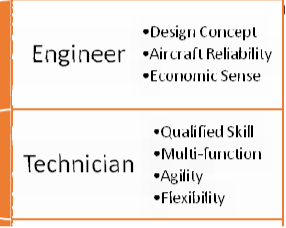
.
Mapping information flows is a process for analysing how information is transferred between two points inside an organization (Hibberd, Evatt 2004). There are two types of information flows: Direct information and indirect information, companies have for a long time tried to optimize and improve the physical material flow within the supply chain but is needed also improve the information which is connected to the physical flow (Chibba, Rundquist 2004).

Figure 17: The physical material flow and the information flow showing two different Approaches
(Indirect and direct information). Source: (Chibba, Rundquist 2004).
Hibberd and Evatt (2004) indicates some benefits of mapping information:
- Enables the understanding of who is the user of information and how is used.
- It identifies the ultimate client or key stakeholder for various types of information services.
- Help to focus information services where more necessaries are.
They also pinpoints a process of five steps to perform the information flow mapping:
- Describe current situation: They suggest a hierarchical chart showing the mission, goals and objectives of an organization, in addition it is also exposed the interaction with various business units and how these units support these goals.


- Describe potential clients: Identification of potential clients in other business units. Determining the organizational goals and objectives of each unit and identify what information may need.
- Map potential clients: Listing the units, needs and resources help to analyse the potential overlap areas, the current client’s maps is completed with the potential client’s information. The map should be completed with suggestions and reallocation of resources, products and services.
- Rank solutions for prioritization: Make a classification of the possible solutions:
- Low Risk: Organizations is not making a mission-critical decision.
- Moderate Risk: Organizational activity involves a complete department and its budget.
- High Risk: Organizations is making a mission-critical decision.
- Create an Information map: Mapping the final solution to show each department and the suggestions for their information, the information map will require updating to continue its function.
Chibba and Rundquist (2004) argues that a data flow diagram (DFD) could be used to map typical supply chain information flows the article present difference commercial solutions for DFD creation and the characteristics for a process:
- Is necessary a supplier that contribute with some measurable entity into the process.
- The process comprises a number of activities that convert the object in a more valuable object.
- The process should have well defined start and concrete ending.
- The process should be regularly iterated.
- The process should use the organization resources.

 Is good for organization to work with a process model that all the member could understand, they should know how their process are connected, the hierarchy, hat resources are critical to the clients.
Is good for organization to work with a process model that all the member could understand, they should know how their process are connected, the hierarchy, hat resources are critical to the clients.
References
AL-KAABI, H., POTTER, A. and NAIM, M., 2007. Insights into the maintenance, repair and overhaul configurations of European airlines. Journal of Air Transportation, 12(2), pp. 27.
AL-KAABI, H., POTTER, A. and NAIM, M (2007) ‘An outsourcing decision model for airlines’ MRO activities’, Journal of Quality in Maintenance Engineering, 13(3), pp. 217-227.
AYENI, P., BALL, P. and BAINES, T., 2016. Towards the strategic adoption of Lean in Aviation Maintenance Repair and Overhaul (MRO) industry: An empirical study into the industry’s status. Journal of Manufacturing Technology Management, , pp. 38-61.
AW&ST. 2015. “Aviation Week Announces Top 10 Airframe MRO Providers: Biennial survey examines MRO developments, 2014 airframe maintenance hours and revenue”. Aviation Week and Space Technology, MRO Edition, Aviation Week Ranks. May 2015.
BIERER, A., GTZE, U., KHLER, S. and LINDNER, R., 2016. Control and Evaluation Concept for Smart MRO Approaches. Procedia CIRP, 40, pp. 700-705.
CHANG, H.M. and ABDULLAH, K., 2014. The Operation Management Model of Aircraft Maintenance, Repair and Overhaul (MRO) Business. International Journal of Trends in Economics Management & Technology (IJTEMT), 3(3),
CHIBBA, A. and RUNDQUIST, J., 2004. Mapping flows-an analysis of the information flows within the integrated supply chain.
Chris MARKOU Assistant Director, IATA Operations, MRO, December 2015 Airline maintenance cost executive commentary: public mctf An Exclusive Benchmark Analysis (FY2014 data) by IATA’s Maintenance Cost Task Force.
FLOURIS, T.G. and OSWALD, S.L., 2006. Designing and executing strategy in aviation management. Ashgate Publishing, Ltd.
HIBBERD, B.J. and EVATT, A., 2004. Mapping information flows: a practical guide. Information Management, 38(1), pp. 58.
IYENGAR, N., DHARWADA, P., KAPOOR, K., GRAMOPADHYE, A. and GREENSTEIN, J., DEVELOPMENT OF A KNOWLEDGE MANAGEMENT SYSTEM TO REDUCE ERRORS IN AVIATION MAINTENANCE.
M. TAAFFE, K., WILLIAM ALLEN, R. and GRIGG, L., 2014. Performance metrics analysis for aircraft maintenance process control. Journal of Quality in Maintenance Engineering, 20(2), pp. 122-134.
SAHAY, A., 2012. Leveraging information technology for optimal aircraft maintenance, repair and overhaul (MRO). Elsevier.
VIEIRA, D.R. and LOURES, P.L., 2016, Maintenance, Repair and Overhaul (MRO) Fundamentals and Strategies: An Aeronautical Industry Overview.
Cite This Work
To export a reference to this article please select a referencing stye below:
Related Services
View allDMCA / Removal Request
If you are the original writer of this essay and no longer wish to have your work published on UKEssays.com then please click the following link to email our support team:
Request essay removal



